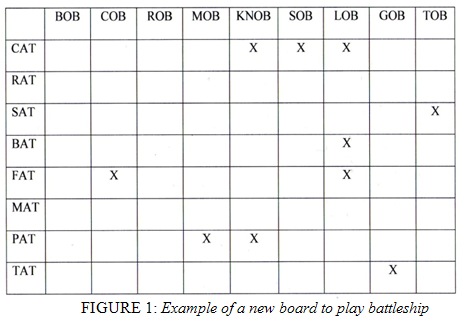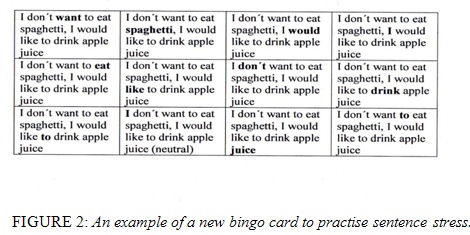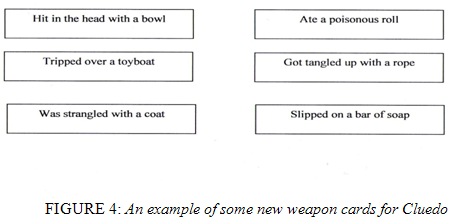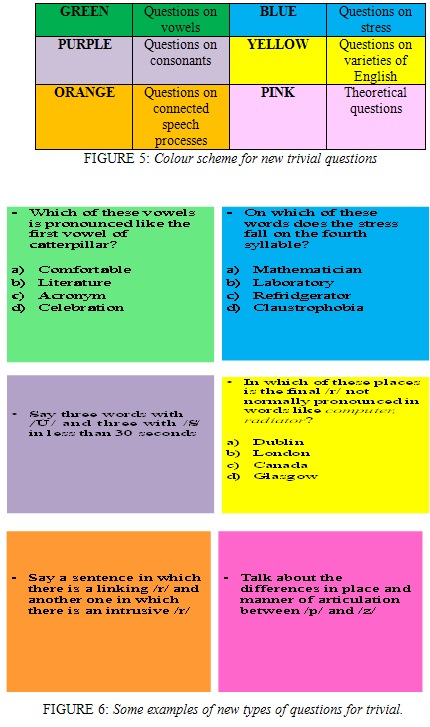Using Traditional Board Games in EFL Classes to Focus on Pronunciation
Yolanda Joy Calvo Benzies, Spain
Yolanda Joy Calvo Benzies holds both a BA and an MA in English Language and Literature from the University of Santiago de Compostela. She is currently a PhD student at this university. Her PhD is devoted to the role that pronunciation has in EFL classes and materials in Spain. She has presented at several national and international conferences and is a member of the SPERTUS group (Spoken English Research Team at the University of Santiago de Compostela).
E-mail: yolandajoy.calvo@rai.usc.es , yolyjcb@hotmail.com
Menu
Introduction
Step 1: choosing the correct type of game
Step 2: other factors
Adapting traditional board games to the teaching of pronunciation
Indoor games
Outdoor games
Concluding remarks
References
Although the language teaching field has undergone a high number of changes in the last decades (the introduction of a more communicative way of teaching, the publication of the CEFR, the influence of ICTs, new approaches such as CLIL), pronunciation is still rather misplaced in EFL classes in Spain if compared to other language areas such as, grammar, vocabulary or writing (Wei, 2006; Griffiths, 2004; Derwing, 2010; Underhill, 2010; Fouz and Mompean 2012). Several reasons may explain this situation: 1) speaking and pronunciation activities are often regarded as time-consuming; 2) in the majority of cases, the number of students per class is unfortunately still too high; 3) the presence of pronunciation in EFL textbooks used in Spain is quite poor and the few activities suggested may be unappealing to the students since they share a similar format, i.e, repetitions and imitations (Calvo, 2013), and; 4) Spanish EFL teachers lack the necessary training to feel confident enough to teach pronunciation.
Nowadays, as mentioned before, the use of ICTs is becoming quite popular in language classes and thus, teachers need to become familiar with these gadgets, even though in some cases it might be quite challenging and frustrating. However, before one becomes a professional in new technologies, teachers could still use one of the most entertaining resources existing in language teaching, i.e, games, for the teaching of all kinds of language skills and areas, including pronunciation.
Games are part of student’s daily lives and thus, teachers should take advantage of this situation to make their pronunciation classes more attractive. Other reasons so as to use games in the language classroom are: a) there are hundreds of types of games to choose from, hence, giving teachers the possibility of choosing certain kinds for their specific students´ needs, preferences and so on; b) they engage and motivate students since they feel the necessity to compete against their classmates, knowing that they have the chance of winning at the end and thus, obtaining some kind of personal and/or material reward.
Previous research has indicated that the use of games in the language classroom has positive effects on many language skills, such as, for the teaching and learning of grammar (Lawrence and Lawrence 2013, Trong and Minh, 2010) and vocabulary (Alemi, 2010). Concerning pronunciation, several authors (Kenworthy, 1987; Laroy, 1995; Hancock, 1995; Pennock and Vickers, 2000; Paz, 2000; and Palacios, 2000) have encouraged teachers to use games in EFL classes to practise both segmental and suprasegmental features. However, they mostly suggest games of their own creation. Nevertheless, if teachers make use of games their students are familiar with, the learning process may be (even) more successful. Therefore, this paper aims at 1) adapting some traditional games such as Bingo, Cluedo, Monopoly, Battleship or Twister so as to practise different aspects of English pronunciation and 2) providing some practical examples and ideas of such adaptations.
Before outlining these activities, in the next paragraphs, we will briefly discuss some steps teachers should follow when designing such tasks.
Before choosing a traditional board game to be used in the classroom, teachers should take into consideration their specific students´ needs as well as their personal and social background. To do so, it is important to take two things into account: a) the students should be familiar with most of the vocabulary they will need to correctly play the games and, b) the games chosen should be appealing to a certain group of learners in terms of age group, gender, level of English... so as to avoid them getting bored or finding the activity too easy or difficult to carry out. For instance, children and teenagers would probably benefit more from playing highly active games such as hopscotch or twister than adults would; on the other hand, adult learners may prefer to play less active games such as trivial or cluedo. Choosing the right type of game for our learners is therefore crucial to avoid them getting bored and hence, unmotivated.
Some other factors teachers should take into consideration when using games in their classrooms are:
- Time to be spent on a particular game and the amount of times games will be used in the classroom as a general rule: as was mentioned in the introduction, games are a very motivating and entertaining way of teaching English; nevertheless, as with every type of technique in EFL classes, teachers should not overuse them since students should also be able to learn aspects of English pronunciation using a variety of techniques and materials, such as songs, computers or role-plays.
- Physical space: another aspect to bear in mind is the physical space in which the game can be played, i.e, inside or outside the classroom, on the beach, in the playground... This may require previous preparation by the teacher in order to book a specific classroom that contains, for instance, circular tables so students can work in groups or organising a day-trip to the beach on which certain games could be played.
- Number of students per game: thirdly, teachers need to decide how they are going to divide their students up; this could be done in pairs, small teams, the whole class playing the same game or several groups playing different games and so on.
In order to classify the games that will be presented here, we have decided to divide them into two main groups. On the one hand, games which are commonly played indoors and on the other, games that can be carried out outside.
a. Battleship
A guessing game played by two people in which each player has two grids that normally have numbers from 1 to 10 vertically and the letters A-J horizontally. On one of the grids, each player arranges their ships and on the other they record their own shots.
Teachers or students could make their own grids and, instead of letters and numbers, minimal pairs could be used, for instance. In figure 1 we can see an example in which students practise minimal pairs with the sequences /æt/ and /ɒb/.
As in the original game, students would have to select a horizontal word and a vertical one, for instance, “bat-rob” and if the other player has a boat or part of a boat in that square, they would say “sunk” or “touched”; however, they would say “water” if there was no boat in that space.
This game could be ideal for A2/B1 students who are beginning to learn how to discriminate English sounds. The minimal pairs used could be adapted according to the level of the students, for instance, for B1/B2 ones, minimal pairs with /æ/ and /^/ or /ð/ and /Ɵ/ could be used, since they are instances of sounds that are commonly difficult for Spanish learners of English, even at advanced levels. Moreover, we could also adapt this game to focus on suprasegmental aspects: a) word stress: insert nouns and verbs in which the stress changes such as, conduct, escort, insult or record; b) intonation: practising intonation while students ask questions like “Is your ship in the square cat-lob?”

b. Bingo
A game of chance in which students have cards with several numbers on them. Another player randomly reads out different numbers and the first player to cross out all of their ones, wins.
Nowadays, the so-called phonetic bingo is quite popular. In this game, minimal pairs are commonly used. However, teachers could also use this game to practice for instance, sentence stress. In figure 2 we find an example in which similar sentences are found but a different word is emphasized in each of them, thus making students perceive the speakers tone of voice when focusing on different items to transmit different types of information.

c. Snap
A card game in which there are groups of cards with varied pictures on them. The cards are divided into all the players and, one by one, a player has to turn one over and place it in the centre of the table and the next player does the same in a more or less rapid way until two equal cards appear one after the other. When this happens, the players quickly have to place their hands on the pile of cards and say ʿSnapʾ. The player that first does this, wins all the cards from the pile.
This game could be adapted to B2/C1 students, for instance, if the objects on the different cards represent homophone words (weak-week, key-quay, course-coarse, saw- sore) or even real or nonsense transcribed words (for instance, stethoscope -/´steθƏskƏƱp/ or psychologist - /saɪ´kɒlƏʤɪst/ for real words versus /stƏ´θa:skæp/ or /sƏ´kƆ:lƏʤ^st/ for invented nonsense words.
d. Monopoly
A board game in which the main aim is for the players to buy plots of land (properties – different colour cards) on which they can afterwards build houses and hotels. If another player lands on their properties, they have to pay the owner different amounts of money depending on the value each card is worth. The winner is who has the most properties and money at the end and is capable of making the rest of the players go bankrupt.
An adaptation for this game could be for each card colour-scheme to represent examples of street-names with different English vowels (cf. figure 3, below), thus forcing the students to use items that contain most of English short vowels as well as practising their speaking and listening skills at the same time.

e. Cluedo
A detective board game in which one has to discover who the killer of the servant was, in what room did the murder take place and what weapon was used. Each player begins with a certain amount of cards; to obtain further information, each player in turns has to ask the person on their right questions and at the same time guess what cards each player has by paying attention to everyone´s answers. Whoever correctly guesses the killer, room and weapon used, wins the game.
So as to adapt this game to the practicing of English pronunciation integrated within other skills, in this case, with speaking and listening, the original names of the suspects (Mrs White, Coronel Mustard…) and the rooms (conservatory, kitchen, ballroom…) could be maintained whereas the weapons could be substituted, for example, by bowl, roll, toy boat, rope, coat and soap, to emphasize the diphthong /ǝʊ/; hence, the new weapon cards could be as followed:

In order to cross out further information, each player would have to ask the rest of the players questions like ʿWas the servant hit on the head with a bowl by Mrs White in the dining room?ʾ, ʿDid the servant eat a poisonous roll made by Reverend Green in the living room?ʾ or ʿDid the servant trip over a toy boat left deliberately by Miss Scarlet in the kitchen?ʾ In this new version of Cluedo, students would also be practicing intonation in questions.
Another possible entertaining and engaging adaptation could be to replace the suspects´ original names with some of the students´ names and thus, one of them will be the killer without even knowing it.
f. Trivial
A question game in which each group of cards represent a topic (green for science and nature, purple for art and literature, etc).
This game could be used, for instance, with B2/C1 students who are familiar with English sounds and with some theoretical concepts. The different colour-cards could represent questions on different aspects of English pronunciation, some of them being perceptive questions and others productive. For example, figure 6 below contains some examples of questions that could be designed:

a. Twister
A physical game in which there is a mat with blue, green, red and yellow circles and a board with a spinning arrow on it. The arrow is spun and depending on what colour and part of the body it falls on (left hand/right hand/left foot/right foot), the player has to put that body part on a certain circle. The players get tangled up and the last one to lose their balance wins.
This game could be used for A2/B1 students if each group of circles represent a different consonant. For instance, red for words that begin with /p/, green for /t/, yellow for /d/ and blue for words that start with /g/. If the board lands on, for instance, pen and right foot, students would have to put their right foot on a red circle. Another adaptation in which students would be directly involved from the beginning would be to make a gigantic mat on which the whole class could play at the same time, getting tangled up with more people and, at the same time, competing against more players.
b. Hopscotch
A hopping game in which one by one, each player has to throw a stone on a different square each round (beginning with numbers 1, 2 and so on until they reach the last square), and after they have to hop on all the squares but avoid touching the one their stone is on.
For B1/B2 students, teachers could add more squares and maybe ask each player a question related to English pronunciation before they begin each round, such as, ʿname three words that rhyme with gameʾ; ʿread the following transcriptions: /ʤ^ʤ/, /beɪʒ/, /ʃɒp/ʾ; ʿwhat is the difference between these two words: cat and Kate?ʾ or ʿhow many syllables are in the words literature and scientific? ʾ If the students get the question right, they can continue with their go; if they get it wrong, they have to go back a square.
c. Tag and cheese
A chasing game in which whoever is it, has to chase the rest of the players. There are several versions of this game: 1) when the it player catches somebody, they become the new it person and chase the others or 2) when the it player catches someone they also become it players who have to chase the rest of non-it people. The last player to become an it, wins.
This game could be played with especially A2/B1 students. Either version could be played but the new change is that the it person (or people) have to say a word beginning with an , or consonantal cluster whenever they catch somebody. For B2/C1 students, teachers could use tongue twisters previously practised in the classroom such as, 1) The thirty-three thieves thought that they thrilled the throne throughout Thursday; 2) Sheena leads, Sheila needs; or, 3) Roberta ran rings around the Roman ruins.
As can be observed throughout this paper, it is not difficult to adapt common games to the teaching of pronunciation. The only thing teachers need to have is some creativity, basic knowledge of English pronunciation and interested students who enjoy learning English with new methods, in this case, with games. Moreover, teachers should remember that pronunciation, as well as any other language skill or field, should not be taught in isolation and thus, they should try and invent games in which students, apart from perceiving and/or producing any aspect of pronunciation, also practise other skills: speaking, listening, the learning of new vocabulary or even writing.
Since students are used to playing these kinds of games outside language classes, transferring them into the classroom could be an excellent way of engaging them to have fun while practising English pronunciation.
This paper is part of a larger project, namely a PhD dissertation that is concerned with the role that pronunciation currently has in EFL classes and materials in Spain at different levels of education. Spanish learners of English tend to have serious problems with English pronunciation, even at advanced levels and there continues to be a lack of exposure to English outside the classroom. Moreover, as mentioned in the introduction, the pronunciation activities present in Spanish EFL textbooks tend to follow a repetitive format, mainly that of simple repetitions and discriminations (Calvo, 2013). Hence, a remedial programme such as the one suggested in this article may motivate both teachers and students to use more engaging kinds of activities available for emphasising as well as integrating pronunciation into the classroom.
Alemi, M. (2010). “Educational games as a vehicle to teaching vocabulary.” MJAL 2: 6, pp. 425-438.
Calvo Benzies, Y.J. (2013). “La enseñanza de la pronunciación del inglés en Galicia: una asignatura pendiente.” In Cabedo Nebot, A., Aguilar Ruiz, M.J., López-Navarro Vidal, E. (eds.), Actas del XLI Simposio Internacional de la Sociedad Española de Lingüística (SEL). Estudios de lingüística: investigaciones, propuestas y aplicaciones. Valencia: Universitat de Valencia, pp. 13-20.
Derwing, T. (2010). “Utopian goals for pronunciation teaching”, in Levis, J., Levelle, K. (eds.), Proceedings of the 1st Pronunciation in Second Language Learning and Teaching Conference. Ames, IA: Iowa State University, pp. 24-37.
Fouz, J. & Mompean, J.A. (2012). “Twitter and English Pronunciation Teaching.” Proceedings of the 5th ICT for language learning. Florencia: Libreriauniversitaria.
Griffiths, B. (2004). “Integrating pronunciation into classroom activities”. Teaching English. BBC Council [online], Available on:
www.teachingenglish.org.uk/article/integrating-pronunciation-classroom-activities [accessed January 2014].
Hancock, M. (1995). Pronunciation games. Cambridge: Cambridge University Press.
Kenworthy, J. (1987). Teaching English pronunciation. New York: Longman Group UK Limited.
Laroy, C. (1995). Pronunciation. Oxford: Oxford University Press.
Lawrence, J. & Lawrence, A. (2013). “Attitude of student teachers towards using grammar games for teaching English.” International journal on new trends in education and their implications. Vol. 4, issue 1; pp. 65-72.
Palacios Martínez, I.M. (2000). “Improving learner´s pronunciation of English: some reflections and some practical tips”. In Ruiz J.M., Sheerin P., Estebánez C. (eds), Estudios de metodología de la lengua inglesa. Valladolid: Universidad de Valladolid, pp. 17-40.
Paz Framil, A. (2002). Funny stories for remedial pronunciation self-study and classroom. Santiago de Compostela: Universidade de Santiago de Compostela.
Pennock, B. & Vickers, P. (2000). “Some notes on the teaching of English pronunciation”. In Ferrer Mora H., Pennock Speck B., Bou Franch P. & Gregorii Signes C. (eds), Teaching English in a Spanish setting. Valencia: Universidad de Valencia, pp. 231-241.
Trong, L. and Minh, N. (2010). “Teaching English grammar through games”. Studies in language and literature. Vol. 1, issue 7, pp. 61-75.
Underhill, A. (2010). “Pronunciation – the poor relation?” Teaching English. BBC Council. [online], Available on
www.teachingenglish.org.uk/articles/pronunciation-poor-relation [accessed January 2014].
Wei, M. 2006. “A literature review on strategies for teaching pronunciation”. (ERIC Document Reproduction Service No. ED 491566). Available on
www.eric.ed.gov/PDFS/ED491566.pdf [accessed January 2014].

Please check the Teaching Pronunciation at Pilgrims website.
Please check the Creative Methodology for the Classroom course at Pilgrims website.
Please check the Methodology & Language for Primary Teachers course at Pilgrims website.
Please check the Methodology & Language for Secondary Teachers course at Pilgrims website.


|